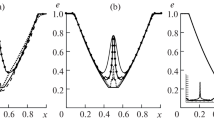Abstract
An accurate particle tracking method for a finite difference method model is developed using a constant acceleration method. Being assumed constant temporal and spatial gradients, the new method permits temporal-spatial variability of particle velocity. Test results in a solid rotating flow show that the new method has second-order accuracy. The performance of the new method is compared with that of other methods; the first-order Euler forward method, and the second-order Euler predictorcorrector method. The new method is the most efficient method among the three. It is more accurate and efficient than the other two.
Similar content being viewed by others
References
Abulaban, A. and J.L. Nieber. 2000. Modeling the effects of nonlinear equilibrium sorption on the transport of solute plumes in saturated heterogeneous porous media.Adv. Water Res.,23, 893–905.
Al-Rabeh, A.H. and N. Gunay. 1992. On the application of a particle dispersion model.Coastal Eng.,17, 195–210.
Bennett, J.R. and A.H. Clites. 1987. Accuracy of trajectory calculation in a finite-difference circulation model.J. Comp. Phys.,68, 272–282.
Bensabat, J., Q. Zhou, and J. Bear. 2000. An adaptive pathlinebased particle tracking algorithm for the Eulerian-Lagrangian method.Adv. Water Res.,23, 383–397.
Cheng, R.T. and V. Casulli. 1982. On Lagrangian residual currents with applications in South San Francisco Bay, California.Water Resour. Res.,18(6), 1652–1662.
Dimou, K.N. and E.E. Adams. 1995. A random-walk, particle tracking model for well-mixed estuaries and coastal waters.Estuar. Coast. Shelf Sci.,37, 99–110.
Foreman, M.G.G., A.M. Baptista, and R.A. Walters. 1992. Tidal model studies of particle trajectories around a shallow coastal bank.Atmos. Ocean,30(1), 43–69.
Hassan, A.E., R. Andricevic, and V. Cvetkovic. 2001. Computational issues in the determination of solute discharge moments and implications for comparison to analytical solutions.Adv. Water Res.,24, 607–619.
Suh, S.W. 1998. Thermal dispersion analysis using semi-active particle tracking in near field combined with two-dimensional Eulerian-Lagrangian far field model.J. Kor. Soc. Coast. Ocean Eng.,10(2) 73–82. (In Korean)
Author information
Authors and Affiliations
Corresponding author
Rights and permissions
About this article
Cite this article
Lee, S., Lie, HJ., Song, KM. et al. A second-order particle tracking method. Ocean Sci. J. 40, 201–208 (2005). https://doi.org/10.1007/BF03023519
Received:
Revised:
Accepted:
Issue Date:
DOI: https://doi.org/10.1007/BF03023519




